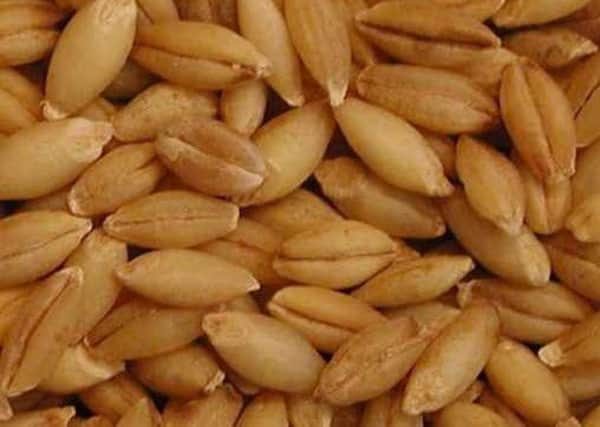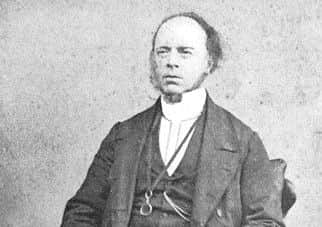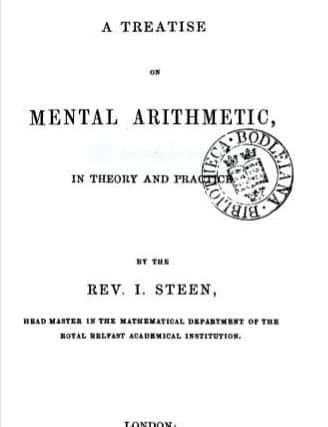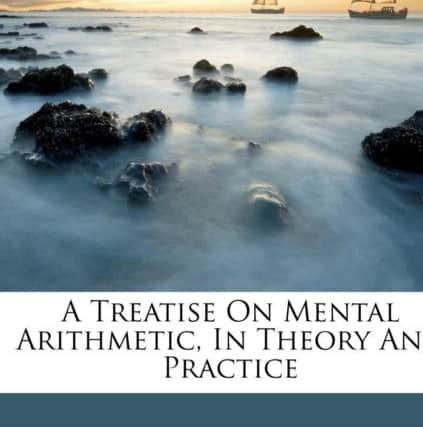Local maths teacher and clergyman was much admired for his mental arithmetic


The horticulturally-sourced measurement was included in the following three questions from the book’s opening chapter:
“How many times would a carriage wheel, which is two yards in circumference, go round between Belfast and Dublin?
Advertisement
Hide AdAdvertisement
Hide Ad“Three barleycorns laid end to end make one inch, how many barleycorns would reach from Belfast to Ballymena?


“If a man in walking takes a yard at every step, how many steps will he take between Londonderry and Coleraine?”
Answers are at the bottom of this page, following a far-too-fleeting introduction to the 1842 maths book and it’s author.
“Here’s a rare one,” a reader’s rather tantalising note to Roamer began recently, ending succinctly: “See Rev Steen!”
Advertisement
Hide AdAdvertisement
Hide AdThe Reverend Isaiah Steen, minister of the Presbyterian congregation in Ballycopeland, Co Down, was born near Coleraine in 1798.


He resigned from his congregation in 1832 and became head of maths in the Royal Belfast Academical Institution.
The reader’s note of introduction included a website biography of Rev Steen from Eddie’s Extracts – a predominantly Presbyterian history resource at www.eddiesextracts.com.
The profile outlines “a gifted and painstaking teacher and the author of ‘Steen’s Mental Arithmetic.”
Advertisement
Hide AdAdvertisement
Hide AdThe book was summarised by Steen as “a treatise on mental arithmetic in theory and practice”, and it was said to be very popular with teachers and, less plausibly, with pupils!


But ‘Steen’s Mental Arithmetic’ enjoyed extensive sales, a fourth edition being published two years after the first print-run in 1844.
It was published by the Dublin, London and Glasgow-based educational printing company Simpkin and Marshall, whose ‘Select List of School Books’ encompassed tempting tomes like Virgil’s Bucolics With Literal Translations into English Prose, and Bosworth’s Compendious Grammar of the Primitive English or Anglo-Saxon Language!
Other alluring titles proffered by Simkin and Marshall included Cowie’s Questions on Ditto, Hodgkin’s Sketch of the Greek Accidence and Crombie’s Etymology and Syntax.
Advertisement
Hide AdAdvertisement
Hide AdBut we’ll leave those scholarly treasures for another day, and concentrate for now on Steen’s Mental Arithmetic and its author.
Isaiah Steen was born in Balleney, near Coleraine, in 1798.
His father John, of Scottish descent, married Nancy (nee Schoals) in 1778, and had six sons – James, Thomas, Conolly, Philip, John and Isaiah Steen.
Isaiah was educated at the RBAI and got his General Certificate in Arts in 1818.
Advertisement
Hide AdAdvertisement
Hide AdHe completed his theological training in 1822 and became minister of Ballycopeland Church in 1823.
Rev Steen married Isabella Carmichael from Millisle on July 12, 1824 and as there wasn’t a manse in Ballycopeland, they lived in Donaghadee.
Regarded by all as a hard worker, a diligent pastor, a saintly scholar, and “a fervent and eloquent preacher of the everlasting Gospel”, Isaiah was elected Moderator of the Secession Synod in 1831.
He was greatly loved by his congregation and when he became head of maths at Inst in 1832 they were extremely saddened to see him go.
Advertisement
Hide AdAdvertisement
Hide AdWhilst in charge of RBAI’s so-called ‘Mathematical and Mercantile School’, he was cherished by students and staff as a gifted and painstaking teacher.
His 196-page schoolbook about mental arithmetic starts with a basic introduction which vividly characterises the era:
“Mental arithmetic is the method of calculating in the mind, without the use of paper or slate, or anything else on which to perform the operation.
“The following rules do not, by any means, comprehend all that might be given on the subject.”
Advertisement
Hide AdAdvertisement
Hide AdIsaiah’s introduction continues: “They are only a selection of rules that will materially assist in preventing that slavish dependence on the use of a slate or paper, so much complained of.”
Hereafter in his book – which I’ll return to soon on Roamer’s page – Isaiah outlines the absolute fundamentals of mental arithmetic using explanations and techniques that’ll bring tears to the eyes of anyone today who remembers learning about two-times tables, pints in a gallon or inches in a foot!
It’s a hefty tome, which is stressed at the very start of the book – “the pupils, after having been sufficiently exercised in performing, mentally, exercises in Reduction, Simple and Compound Addition, Subtraction, Multiplication, and Division, should then be introduced to other chapters, in succession, as they may be found capable.”
Everything mathematical is there, in detail, reminding today’s readers how times have changed: “Though the pound avoirduois (sic) is heavier than the pound troy, the ounce troy is heavier than the ounce avoirdupois. The ounce troy contains 480 grains, and the ounce avoirdupois only 437 grains. 175 ounces troy are equal to 192 ounces avoirdupois; but 175 pounds troy are equal to only 144 pounds avoirdupois.”
Roamer is very glad he wasn’t at school in 1842!
Advertisement
Hide AdAdvertisement
Hide AdFinally today, a barleycorn was an Anglo-Saxon unit of length that’s still used in the shoe industry.
It’s the length of a grain of barley, or about 1/3 inch, and you’d need 241,920 of them, end-to-end, to reach from Belfast to Ballymena.
Isaiah’s carriage wheel would turn round 89,600 times between Belfast and Dublin; a man “in walking” would need to take 52,800 steps to get from Londonderry to Coleraine and the Reverend Steen taught mathematics in Inst until 1869.
He died on August 3, 1871 aged 73 years.